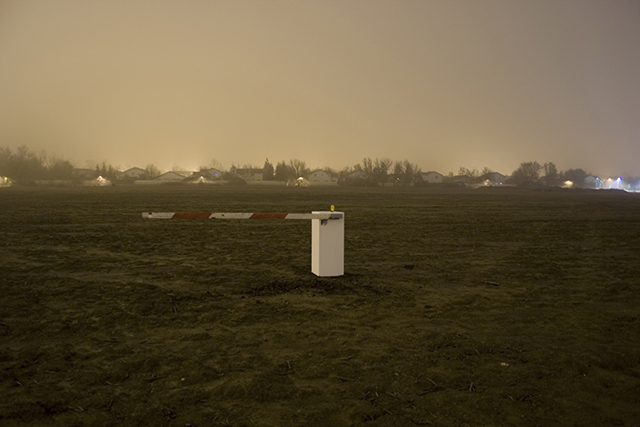Curatorial Statement
Liss LaFleur
Assistant Professor of New Media, University of North Texas
Ash Eliza Smith
Director for Art and Technology, Culture, Art and Technology Program, University of California, San Diego
Participating Artists:
Bug Davidson, Jess Dugan, Carrie Fonder, Erin Gee, Adela Goldbard, Kaitlyn Hunter, Angela Jennings, Jeremiah David Jones, Hye Young Kim, Frankie Martin, Elle Mehrmand, Jonathan Molina-Garcia, Kean O’Brien, Kristin Stransky, Paul Taylor, Angela Washko, Chris Wille, Visual AIDS
How do specific identities establish one’s relationship to existing economic orders? How can subversive identity configurations undermine established economies and create alternative economies? Presenters in this session explore how new media representations of identity relate to established and alternative economic orders.
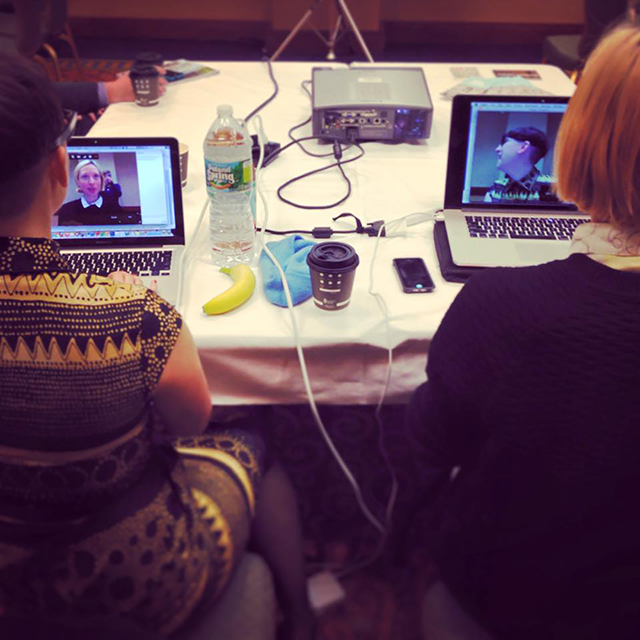
Still from Disrupting Bodies, Disrupting Narratives event, 2015, Liss LaFleur, ©Liss LaFleur (Used with permission.)
When tasked with jurying a selection of new media artists for an experimental session as part of the New Media Caucus’ Alternative Economies: Identity, Configurations, Outsiders of Economic Order, we decided to respond by creating a new framework entirely. For the exhibition, titled Disrupting Bodies, Disrupting Narratives, we invited artists to respond to the idea of disruption through a set of unconventional presentations, performances, and discussions.
As both a curatorial strategy and a provocation, work was selected based on the transformative ways artists manipulate narrative and the body. The framework was loosely defined by Bodies, encompassing gender, sexuality, class, race, (dis)ability, sentient beings, future bodies, labor, and/or community, and Narratives as the reframing of historic and future narratives by questioning power and its relationship to storyteller/storytelling. It was a goal to select a dynamic selection of artists whose work exists outside of the mainstream and responds directly to notions of otherness, whether in concept or form.
Disrupting Bodies, Disrupting Narratives considers: What is an outsider perspective? What might it become? Who gets to tell the past and who gets to tell the future? How might ‘Narrative’ operate as a technology? How can the body itself be technology while other kinds of technologies form future bodies and new ideas of embodiment? How do bodies interfere with narrative? What is a rebel body, and how is it formed or tamed? What is its relationship to labor? How are stories or narrative shared or silenced? What are the economics of narrative capital? How does culture respond to wanting labor but not necessarily wanting certain kinds of bodies? What is the future of disembodied labor? As curators, we sought work that responded to these questions and ultimately found a burgeoning conversation.
The artists in Disrupting Bodies, Disrupting Narratives share many similar questions surrounding technology’s role in relation to visibility, race, gender, age anonymity, avatars, hacking, humor, and pain, yet also consider many of these things technologies in and of themselves. The work considers both narratives and bodies that are in flux or that occupy a liminal place, and utilizes narrative, performance and new media in hybrid ways to ask questions about outsider perspectives, the body and technology, and art as activism. The following is an interrogation of what interested us about these individual artists and pieces.
Angela Washko’s Playing A Girl – The Council on Gender Sensitivity and Behavioral Awareness in World of Warcraft thinks about anonymity and bodies in a virtual space within the game narrative. Her work examines avatars and their relationship to the notion of accountability.
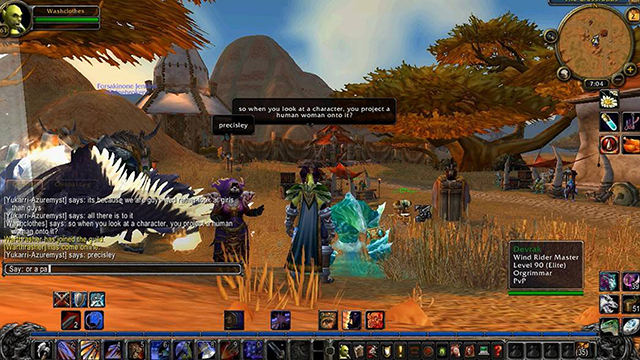
Playing A Girl -The Council on Gender Sensitivity and Behavioral Awareness in World of Warcraft, 2013, Angela Washko, © Angela Washko. (Used with permission.)
Accountability and anonymity are also entangled in Anonymous Infrastructures by Paul Taylor. These site-specific installations consider bodies, patterns and flow, and may extend out to think about who gets to pass and who doesn’t get to pass. His work points to how the built environment shapes our shared lived experience and architecture’s direct relationship to future building and world making. Taylor says:
Certainly my ‘interventions’ could be construed as subversive, as I’m not generally getting permission from the establishment to install them (thus operating as an outsider), and am raising questions that challenge the status quo, such as: how do everyday structures support or control our behavior, including our movements through our environment? who put those structures in place? also, with regards to the structures and economies that support public art, I’m interested in examining the hierarchies that create value in certain objects (public sculpture, etc.) while other objects remain so anonymous we often don’t even notice them . . . [1]
Similarly, Kean O’Brien’s Transient Exhibition positions the pop-up exhibition as a strategy to think about public space, private space and non-permanence in relationship to mobility and visibility. Transience intersects with the demand of labor in Jeremiah Jones’ The Information. This experimental video takes place in various Walmart parking lots in North Dakota and is composed entirely of found YouTube footage shot by or about migrant workers in the oil boom.

Lobo, 2013, Adela Goldbard, digital still from short film, © Adela Goldbard. (Used with permission.)
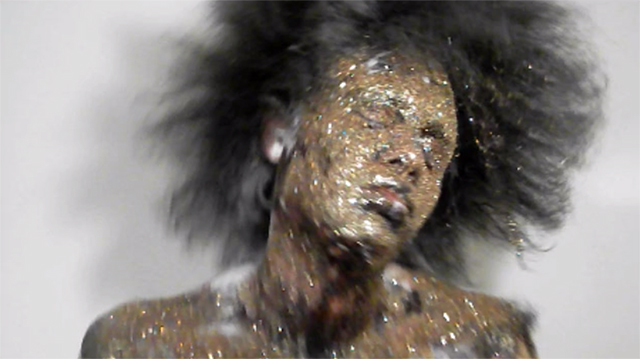
Transform Me Fela, 2013, Angie Jennings, digital still from short film, © Angie Jennings. (Used with permission.)
Myth, ritual, and transformation are examined as a kind of technology in Lobo and Cajero Automático (ATM) by Adela Goldbard, Transform Me Fela by Angie Jennings, and Intimate Distance by Hye Young Kim. These film and video pieces use various techniques ranging from pyrotechnics, music, and performance to think about destruction and metamorphosis. A formal destruction occurs to the device of narrative in Bug Davidson’s film, Nothing Like Ivanhoe, in which notions of both experimental and queer cinema are explored.
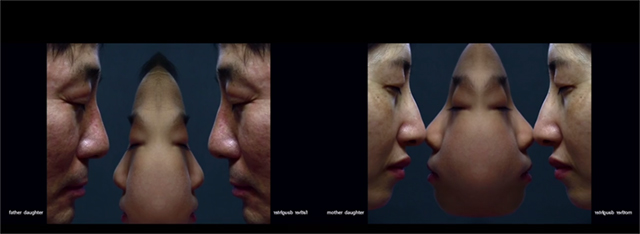
Intimate Distance, 2014, Hye Young Kim, digital still from short film, © Hye Young Kim. (Used with permission.)

Nothing like Ivanhoe, 2014, Bug Davidson, digital still from short film, © Bug Davidson. (Used with permission.)
Body fear is scrutinized in Kaitlyn Hunter’s Cacomorphobia. In her performance-based sculptures, Hunter takes the concept of the ‘fat suit’ and pushes it to the extreme. Performing in public spaces, she hopes to “physically depict the grotesque and repugnant way she is perceived every day.” [2]
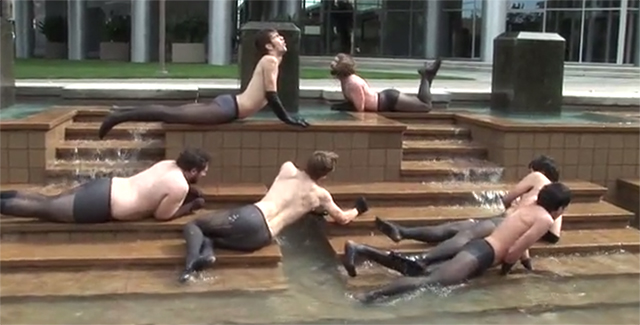
California Seals, 2014, Frankie Martin, digital still from short film, © Frankie Martin. (Used with permission.)
Hunter operates with a kind of uncomfortable humor that is also apparent in Frankie Martin’s California Seals video, in which male bodies stand in for seals splashing about in corporate fountains. Through a kind Jackass-esque performance of masculinity, pain, and humor, Martin examines the environmental impact of commercial development in Southern California.
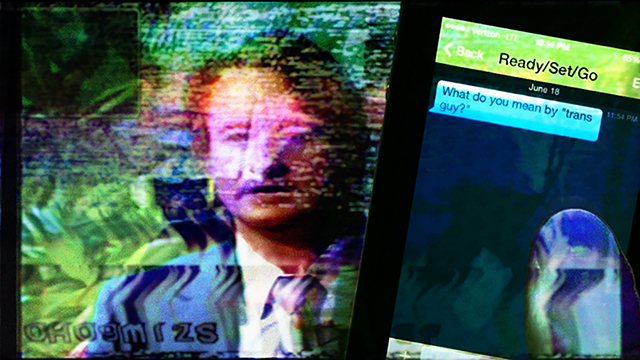
Dear Lou Sullivan, 2014, Rhys Ernst, digital still from short film, © VisualAIDS. (Used with permission.)
Alex Fialho from Visual AIDS uses two videos from the Alternate Endings series, Dear Lou Sullivan by Rhys Ernst and 7 Years Later by Glen Fogel, to raise questions about the role of the archive in regard to infection, confidentiality, aging, and the formation of the rebel body. Aging and relationships are further investigated in Jonathan Molina-Garcia’s video Granddaddy’s Gonna Teach Me a Lesson and in How to Survive the Shore by Jess Dugan. Dugan’s web-based interactive narrative acts as a kind of archive that communicates growing old in the trans community.
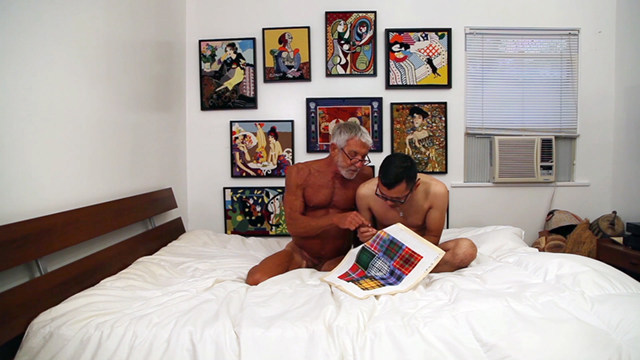
Grandaddy’s Gonna Teach Me a Lesson, 2014, Jonathan Molina-Garcia, digital still from short film, © Jonathan Molina-Garcia. (Used with permission.)
Similar questions and anxieties emerge around in-between-ness and bodies in the kinetic sculpture Recumbence and Trans-co by Carrie Fonder. In Trans-Co, this anxiety is not limited to gender but also tied to race, nationality, consumerism, and transit as well. Fonder says:
The work I made in India entitled Trans-co is an homage to the hijras of Mumbai. Hijras are considered members of the third gender in India; they include transgender, intersex and male individuals, all of whom dress in (mostly) traditional female clothing. They are both honored and marginalized in Indian society. My piece is a cultural mash-up; it depicts a hijra as an icon of feminine beauty on the side of a customized auto-rickshaw (where she becomes a kind of automotive super babe). With wry humor and a kitsch sensibility my piece calls into question the constructs of power that objectify, and at the same time, celebrates the diversity in customization. [3]
For Elle Mehrmand this same diasporic anxiety is analyzed through the process of cloning. Fauxlographic is a performative installation that takes place within an ethno-dysphoric cloning lab where clones enact sonic rituals, singing in Farsi, English, and Perz-ish (a faux diasporic language), based on multiple sources of information, including embodied memories, Wikileaks cables, and textual/visual/aural references concerning Iran and Persia. When high levels of CO2 are detected by the lab’s sensors, the clones become aware of those gazing upon them, resulting in an anxious act of erasure and multiplication of their pixelated flesh.
As in fauxlographic and Alternate Endings (VisualAids), rebel bodies may be tamed and/or liberated through various technologies that gesture toward a kind of future body, the cyborg. Chris Wille’s M.C.U. (Mobile Censorship Unit) uses radio pods to censor the wearer’s view. The device shuts off vision to any wearer who tries to get too close to ‘questionable’ content.
In the opposite vein, titscape, a 3D printed and computer numerical control (CNC) milled electronic board game by Kristin Stransky, creates stimulus (sounds) rather than shuts down stimulus (vision). Provocative audio samples are triggered when various breast-shaped pieces are put into their correct-size slots.
Audio also becomes a space for bending or hacking in Erin Gee’s Voice of Echo works for silent video and data-bent audio. Gee’s work is a body of conceptually driven, cyberfeminist glitch art. Gee says:
There are layers of interrelation that all humans have, where we are objectified, reduced to our utility, treated as objects rather than subjects, reacting to and acting through a subject or group of people more powerful than we are. I think in this way I want to make work that tries to bridge the gap, to create music that has the subject trying to learn the language of the object, to assume that in fact the thing we assumed to be an object in fact has a voice, and it is important to listen. [4]
Much of the discourse generated from the artists and participants in conversation during the New Media Caucus’ Alternative Economies event includes not only the idea of disruption, but is also highly inclined to transgressions and re-formulations of ways of knowing. We found questions surrounding the Disrupting Bodies, Disrupting Narratives exhibition to be both timely and significant, opening a door to richer understanding about the relationships between technology, feminism, activism, and narrative. The exhibition is the first of its kind at CAA and for the New Media Caucus, bringing together artists from across the globe with avant-garde and thought-provoking work. Having many of the artists present their work remotely via Google Hangouts further ruptured the tamed conference space.
References
- Paul Taylor, in email correspondence with Ash Eliza Smith, Feb. 11, 2015.
- Kaitlyn Hunter, in the email submission to Disrupting Bodies, Disrupting Narratives, Dec. 17, 2014.
- Carrie Fonder, in email correspondence with Ash Eliza Smith, Feb. 11, 2015.
- Erin Gee, in the email submission to Disrupting Bodies, Disrupting Narratives, Dec. 31, 2014.
Bios
Liss LaFleur is a New Media artist, scholar, and educator exploring the intersections of storytelling, gender and technology. Her work has been featured internationally in solo and juried exhibitions, film festivals, and on the web, including the TATE Modern, Cannes Court Métrage; online with PBS and POV Digital; the Boston LGBT Film Festival; the Reykjavik Art Museum; Makeshift Boston, and at many colleges and universities nationwide. In addition to co-curating Disrupting Bodies, Disrupting Narrative for the New Media Caucus, she presented on the foundations of transmedia storytelling. LaFleur is currently an Assistant Professor of New Media at the University of North Texas. www.LissLaFleur.com
Ash Eliza Smith is an artist, musician and educator who incorporates strategies of play, speculation and embodied research into her work in performance, experimental pedagogy, and digital media. Smith is currently the Director for Art and Technology in Sixth College’s Culture, Art and Technology Program at University of California, San Diego. In addition to co-curating Disrupting Bodies,Disrupting Narrative for the New Media Caucus, she presented on her work with Edgeland Futurism and The Economics of Futures Thinking in Biotech Beach.
http://asheveryday.com/



